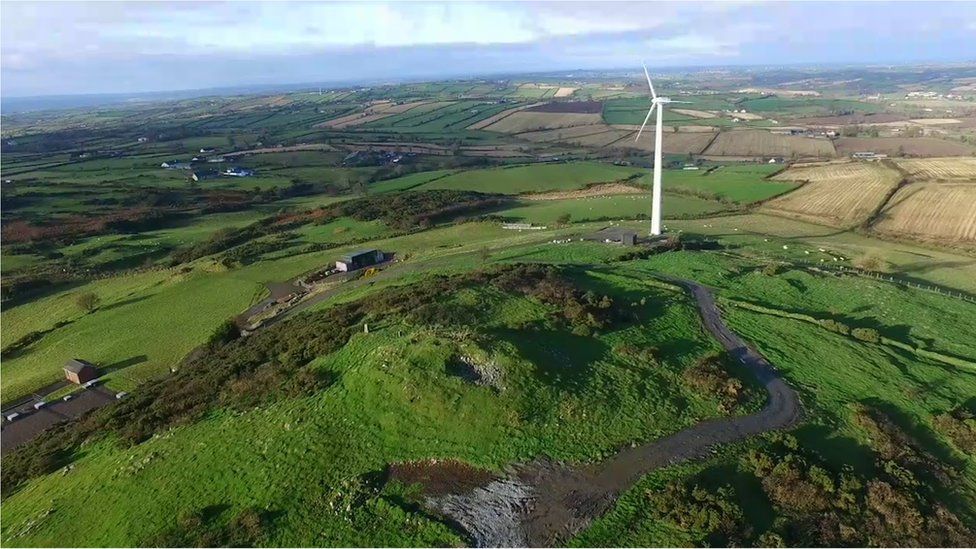Knock Iveagh: Stormont is asked to remove wind turbine at ancient site
- Published

A Stormont department is to be asked to force the removal of a controversial wind turbine built beside a protected ancient burial ground.
The turbine is at Knock Iveagh outside Rathfriland, County Down.
It was erected in 2017, four years after permission was granted by planners at the former Department of the Environment.
It is beside a 5,000-year-old neolithic burial site which is a scheduled historic monument.
Heritage experts who look after monuments were not consulted during the planning process as they should have been and later said they would have recommended refusal.
Planning responsibility passed to Armagh City, Banbridge and Craigavon Council with the reorganisation of local government.
It has been wrestling with whether or not to revoke permission amid suggestions that the compensation bill might be up to £750,000.
The council has now decided how it intends to address the issue.
Powers of enforcement
At a special meeting held behind closed doors, councillors voted to ask the Department for Infrastructure to deal with the matter and compensate the turbine owners if required.
The department has ultimate responsibility for planning in Northern Ireland and can issue an order rescinding permission.
In a statement, the council said it agreed that the turbine was "having an adverse environmental impact on the integrity of the setting of the scheduled monument at Knock Iveagh and the visual amenity and landscape character of the site".
"As a result the council will now be writing to the Department for Infrastructure requesting that it uses its legal powers under Section 75 of the Planning Act to discontinue the use of the land for wind energy generation, and to specify steps for the removal of the turbine and works at the site or exercise its powers of enforcement in respect of an apparent unauthorised development at the site and requesting that the Department for Infrastructure exercise its powers of enforcement before exercising its powers under Section 75 of the Act."
The council said it would also be looking to the department to repay the costs it had run up over several years of trying to resolve the issue.
A spokesman for the Department for Infrastructure said: "The department has not yet received, from the council as the local planning authority, its assessment regarding the case at Knock Iveagh and the final position it has reached.
"It is not therefore possible to provide any comment until the department has received and has had time to consider this information."
The controversy was the subject of a Stormont debate tabled last month by Ulster Unionist Party Assembly Member Doug Beattie.
Mr Beattie said any compensation bill should fall to Stormont rather than on ratepayers in his constituency.
He welcomed the council's decision and said he would lobby departmental officials to make sure they picked up any bill.
"It's a good day for Northern Ireland's shared heritage but there is still some way to go," he said.
South Down MP Chris Hazzard said it was a potential "watershed moment" in the ongoing campaign to protect the site.
"Cnoc Úibh Eachach, or Knock Iveagh, was a focal point for some of the earliest tribe and clan communities in this part of Ireland.
"Historians believe that the summit was the likely inauguration site and ritual area for the Úi Echach Cobha tribe, and later the Lords of Iveagh, the prominent Magennis clan," he said.
"A site of such unique and rich historical, ritual and archaeological significance should not be blighted by any form of development."
The Friends of Knock Iveagh group said they were "delighted" with the council's decision, but its campaign would continue until "the hill is restored and the public can freely visit this important heritage site, as they have for generations".
- Published7 October 2020
- Published7 January 2020